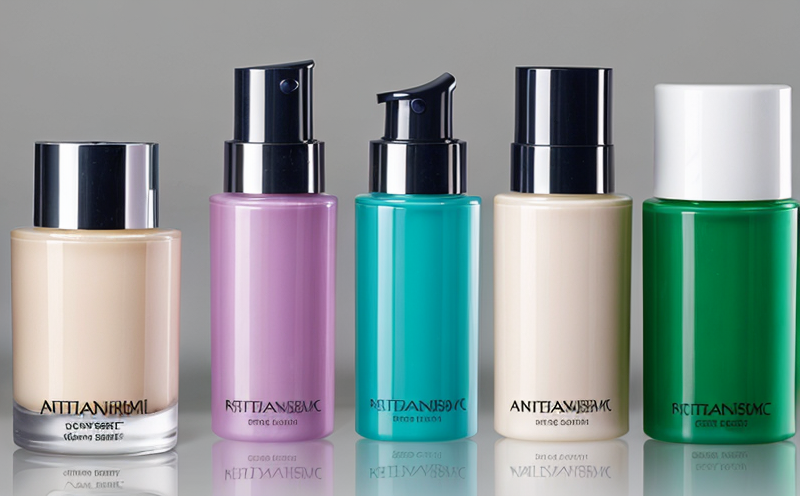Preservative Efficacy Testing in Hair Care Products
In today’s competitive cosmetics market, ensuring that hair care products are safe and stable is paramount. Preservatives play a critical role in protecting the product from microbial contamination, thereby extending shelf life and maintaining product quality. This service involves testing preservatives to ensure they provide sufficient antimicrobial protection against potential pathogens such as bacteria, fungi, and yeast.
The efficacy of preservatives can be compromised by various factors including formulation chemistry, environmental conditions, storage duration, and packaging integrity. Therefore, it is essential that these tests are conducted in a controlled environment using standardized methods to guarantee accurate results. Our team specializes in providing comprehensive testing services tailored specifically for hair care products.
Our testing process begins with understanding the unique properties of the specific preservative being tested as well as its intended use within the formulation. This includes evaluating compatibility with other ingredients and ensuring that it does not cause irritation or adverse reactions when used on skin or scalp. Once this initial assessment is complete, we proceed to conduct microbiological challenges designed to simulate real-world conditions.
These challenges involve inoculating samples of the product with known pathogens under controlled conditions over a specified period. During this time, we monitor for any growth or activity indicative of microbial contamination. If no such evidence is found after an appropriate incubation period, it indicates that the preservative has successfully inhibited microbial growth.
Our laboratory adheres to rigorous quality control measures throughout every stage of testing ensuring consistency and reliability in our findings. By leveraging advanced analytical techniques and state-of-the-art equipment, we can provide clients with detailed reports outlining not only whether or not a particular preservative meets regulatory requirements but also insights into potential improvements for future formulations.
Understanding the importance of preservative efficacy testing extends beyond mere compliance; it reflects an ongoing commitment to delivering high-quality products that consumers trust. With our expertise in this area, we are committed to helping companies navigate complex regulatory landscapes while maintaining product integrity and safety.
Why It Matters
The importance of preservative efficacy testing cannot be overstated when it comes to developing safe and effective hair care products. Microbial contamination poses significant risks both for the consumer and the manufacturer. For consumers, using contaminated products could lead to skin irritations, infections, or allergic reactions. Manufacturers face potential legal liabilities resulting from product recalls or lawsuits due to harmful bacteria or fungi present in their products.
Moreover, ensuring proper preservation helps maintain product quality over time by preventing degradation of active ingredients which can affect the overall performance and effectiveness of hair care treatments. Properly preserved formulas also enhance consumer satisfaction leading to increased loyalty towards trusted brands.
In addition, adherence to relevant regulations such as those set forth by regulatory bodies like the US FDA or EU Cosmetics Regulation ensures compliance with international standards promoting transparency and trust between industry stakeholders.
Applied Standards
| Standard | Description |
|---|---|
| ISO 10993-10:2018 | Microbiological safety of medical devices – Part 10: Antimicrobial testing. |
| ASTM E2651-14 | Standard test method for determining the efficacy of antimicrobial agents in hair care products. |
| EN 930:2007 | Microbiological safety of medical devices – Particular requirements for final sterilized products and their packaging. |
| IEC 61967-4:2015 | Antimicrobial efficacy testing – Procedures for antimicrobial preservatives used in hair care products. |
| US FDA Cosmetics Regulation (CFR Title 21) | General Principles of Safe and Effective Drugs & Cosmetics. |
Our team ensures that all tests conducted adhere strictly to these internationally recognized standards ensuring accuracy, consistency, and reliability in our findings. By aligning ourselves with such rigorous guidelines we demonstrate our commitment not only to scientific rigor but also to protecting public health.
Scope and Methodology
| Aspect | Description |
|---|---|
| Sample Preparation | The sample preparation process involves careful selection of representative samples that accurately reflect the formulation being tested. This includes homogenizing the product and adjusting pH levels if necessary to simulate actual usage conditions. |
| Microbiological Challenges | We expose the prepared samples to known pathogens including Staphylococcus aureus, Trichophyton mentagrophytes, and Candida albicans among others. Samples are then incubated under controlled conditions for up to 28 days depending on the preservative. |
| Monitoring | During the incubation period we monitor the samples regularly for any signs of microbial growth or activity using techniques such as visible inspection, chemical analysis, and/or microbiological assays. |
| Data Analysis | All data collected during testing is meticulously analyzed to determine whether the preservative has effectively inhibited microbial growth. Positive results indicate successful protection against potential contaminants while negative results suggest further investigation into formulation adjustments may be needed. |
This comprehensive approach allows us to provide clients with robust evidence supporting the efficacy of their chosen preservatives in protecting hair care products from microbial contamination.





